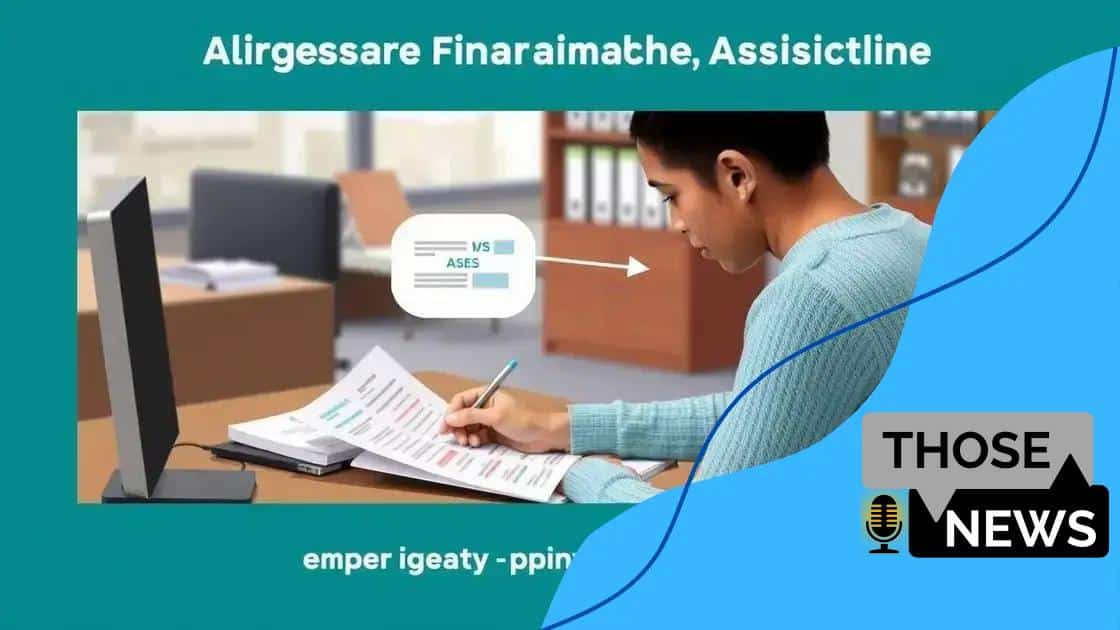Emergency financial aid initiatives that you need to know

Emergency financial aid initiatives offer vital support, including grants and loans, to individuals facing unexpected financial challenges, helping them stabilize their situations and access necessary resources quickly.
Emergency financial aid initiatives are crucial resources designed to help individuals navigate through challenging financial situations. Have you ever wondered how these programs can assist you when times are tough? Let’s explore the many ways these initiatives can offer support.
Understanding emergency financial aid
Understanding emergency financial aid is essential for those facing unexpected financial challenges. This type of assistance is designed to provide help quickly when you need it most. Let’s dive into what these aid programs entail and how they can support you during tough times.
Emergency financial aid can take many forms. It might include grants, loans, or even community support. Each program has its own criteria and process for obtaining help. It’s important to know what’s available to you.
Types of Emergency Financial Aid
Various types of aid cater to different needs. Here are some common forms of support you may encounter:
- Federal grants: These do not require repayment and provide money to help you manage immediate expenses.
- State assistance programs: Many states offer their own aid programs to support residents facing hardship.
- Loan options: While loans require repayment, some offer low interest rates and flexible terms.
- Community resources: Local charities and organizations often step in to provide assistance for essential needs.
Understanding your position can help you navigate these options effectively. Assess your financial situation and identify your immediate needs. This first step will guide you to the right form of aid.
Researching available programs is crucial. Often, local libraries or online resources provide information on financial aid initiatives. Reach out to community organizations as they can often provide personal guidance tailored to your specific situation.
Eligibility Criteria
Most emergency financial aid programs come with eligibility requirements. Knowing these can save you time and help you apply to the right resources.
- Proof of income and need.
- Documentation of expenses or bills.
- Residency requirements in some cases.
- Your financial history.
Keeps these factors in mind as you explore various options. Each program will have different documentation needed, so be prepared to provide your information clearly.
In conclusion, familiarizing yourself with emergency financial aid empowers you during financial distress. With the right information, you can swiftly find the support necessary to stabilize your situation.
Types of financial aid initiatives available
Types of financial aid initiatives available play a vital role in helping individuals facing economic challenges. These programs provide various resources and support to assist people in need. By understanding these types of initiatives, you can find the right help for your situation.
Financial aid comes in different forms, and each type serves unique purposes. Below are some prevalent categories of assistance.
Grants
Grants are funds provided to individuals or groups that do not require repayment. They are typically awarded based on financial need or specific criteria set by the granting agency. Here are some common types of grants:
- Government grants: These are funded by state or federal agencies to support various causes such as education, housing, and healthcare.
- Nonprofit grants: Many charities and nonprofits offer financial assistance for individuals in specific communities or groups.
Grants are an excellent option for those seeking support without the burden of repayment.
Loans
Loans provide immediate funds that must be paid back over time, often with interest. While loans require repayment, they usually offer flexible repayment plans. Here are two types of loans available:
- Federal student loans: Designed to help students pay for education, these loans often have lower interest rates and favorable terms.
- Personal loans: These are unsecured loans that can be used for various purposes, including emergencies and consolidating debt.
Understanding the terms and conditions of each type of loan is essential before applying.
Community Support Programs
Many communities offer support programs funded by local organizations. These initiatives often provide a range of assistance, from rental support to food aid. Some examples include:
- Food banks: Local food banks can provide groceries to families in need.
- Housing assistance: Programs that help with rent or utilities can prevent homelessness.
- Job training programs: These can help individuals develop skills for better employment opportunities.
Utilizing community resources can significantly alleviate financial burdens during challenging times.
As you explore the available options, consider your specific needs and situation. By identifying what type of aid is most suitable, you can take steps toward securing the support you need.
How to apply for emergency financial assistance

Applying for emergency financial assistance can be a straightforward process if you know the steps to follow. It’s essential to be well-prepared to ensure that your application is successful. Understanding how to navigate this process is key to receiving the help you need.
The first step in applying is to gather all required documentation. This may include proof of income, bills, and identification. Ensure that you have everything ready to avoid delays in processing your application.
Research Available Programs
Different organizations offer various forms of assistance. It’s important to research which programs can help you best. Look for:
- Government programs: Many state and federal agencies have assistance programs you can apply for.
- Nonprofit organizations: Numerous charities provide financial aid for people in need.
- Community resources: Local help centers can connect you with available assistance.
Getting in touch with organizations directly can also provide insight on what support is available in your area.
Complete the Application
Once you’ve identified the programs, the next step is to complete the application forms. Be honest and thorough while filling these out. Double-check your entries to ensure accuracy. In most applications, you’ll need to provide:
- Your personal information.
- Details of your financial situation.
- Reasons for your assistance request.
After submitting your application, be sure to keep track of your application status. Some organizations provide a confirmation receipt, while others may not. Following up can help you stay informed about your application’s progress.
Be Prepared for Interviews
Some financial assistance programs may require an interview as part of the application process. Being prepared for this can help you make a positive impression. Focus on:
- Being clear and concise when explaining your situation.
- Gathering any additional documents that might be requested during the meeting.
Making a good impression can significantly improve your chances of receiving help. Keep in mind that applying for assistance is a common step for those facing financial difficulties.
Common eligibility requirements
Understanding the common eligibility requirements for emergency financial aid is crucial for ensuring a smooth application process. Each program may have specific criteria, but many share common standards that applicants need to meet. Knowing what these requirements are can help you apply more effectively.
Most assistance programs require proof of financial need. This can include details about your income, expenses, and any immediate financial challenges you are facing. Having this information ready increases your chances of approval.
Key Requirements
Here are some typical eligibility criteria you might encounter:
- Income limits: Many programs have a maximum income threshold that applicants must not exceed. This is often based on federal poverty guidelines.
- Residency status: Applicants usually need to be residents of the state where they are applying for aid. Proof of address may be required.
- Proof of hardship: You may need to explain your financial circumstances, such as job loss, medical emergencies, or unexpected expenses. Supporting documentation strengthens your case.
- Age and family status: Some programs prioritize certain groups, such as seniors, families with children, or veterans.
It’s also essential to consider any specific application deadlines. Some programs may only accept applications during certain periods, so being aware of these timelines is vital.
Document Preparation
Before applying, make sure to gather all necessary documents to prove your eligibility. Common documents include:
- Your pay stubs or tax returns.
- Bank statements that show your financial situation.
- Bills or notices showing your need for assistance.
Staying organized with your paperwork can help speed up the application process.
Building a clear understanding of these eligibility requirements prepares you for applying to emergency financial aid programs. Researching specific requirements for the programs you plan to apply to can also enhance your chances of receiving the help you need.
Real-life success stories of aid recipients
Real-life success stories of aid recipients can inspire and encourage others who are seeking financial assistance. These stories highlight how various programs have positively impacted individuals and families during tough times. Learning about these experiences can show you the potential benefits of applying for aid.
One common example is Sarah, a single mother who faced job loss during the pandemic. After applying for emergency financial assistance, she received a grant that helped cover her rent and food expenses. This support allowed her to focus on finding a new job without the immediate pressure of financial stress. Today, Sarah is employed again and actively shares her story to help others navigate similar challenges.
Support for Students
Another inspiring story is that of Mark, a college student struggling to afford tuition and living costs. After learning about a financial aid initiative at his school, Mark applied and received a scholarship. This scholarship not only eased his financial burden but also motivated him to excel academically. He is now on track to graduate with honors, thanks to the support he received.
Family Support
A family in need of temporary help also found success through community programs. The Johnsons faced unexpected medical bills, which made it difficult to pay their mortgage. They reached out to a local nonprofit organization that provided assistance with their mortgage payment for three months. Thanks to this aid, the Johnsons managed to stay in their home and are now financially stable again. They are grateful for the community support that made a significant difference in their lives.
These real-life stories illustrate how crucial emergency financial assistance can be for individuals and families facing hardship. They not only show the positive impact of such programs but also remind us that there is hope and help available for those in need.
FAQ – Frequently Asked Questions About Emergency Financial Aid
What is emergency financial aid?
Emergency financial aid provides immediate assistance to individuals or families facing unexpected financial hardships.
Who is eligible for emergency financial assistance?
Eligibility varies by program, but generally, applicants must demonstrate financial need, provide documentation, and meet specific criteria.
How can I apply for emergency financial aid?
You can apply by researching local programs, gathering the required documentation, and submitting an application through the respective organization.
What documents do I need to apply?
Common documents required include proof of income, identification, bills showing financial need, and any relevant personal information.





